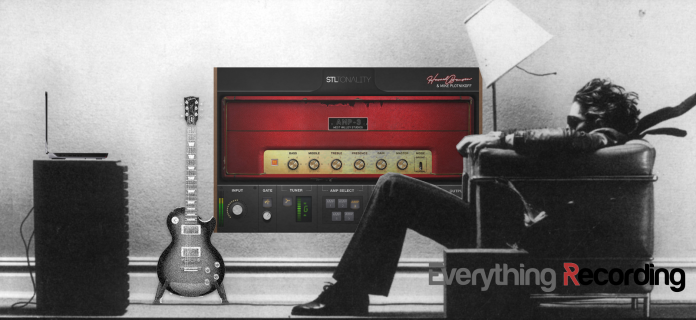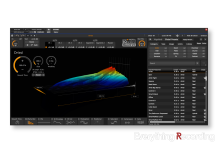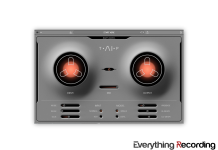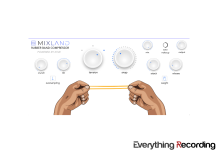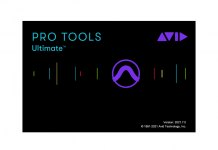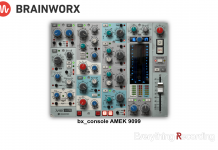IS IT LIVE? OR IS IT TONALITY?
Chris Lord-Alge gets into the mix with STLTones.
GETTING AMPED.
By this point in my wholly unremarkable career I’ve miked up thousands of amps and cabinets in thousands of ways. And while the pursuit of that holy grail tone can be one of the more enjoyable parts of the tracking process, it definitely comes with its own limitations and issues.
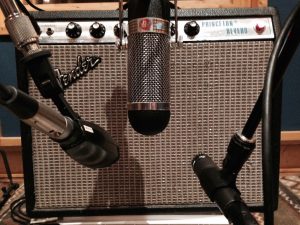
First of all, you can literally spend days swapping and positioning cabinets, mics and moving blankets and still be scratching your head between the monitors saying, “there’s just something not quite there, man.” Move the mic. Now move the other mic. Move the first mic back. Tweak the EQ. Add some compression no, wait, turn that off, we’ll do it later. Did we move the first mic back? After a few hours of this your ears don’t even know if you’re listening to a guitar or a very rhythmic vacuum cleaner (Photo: Sweetwater has a quite intuitive guide for miking guitar amps for those who want to try).
Then there’s the issue of keeping it that way. Boom stands have a dastardly way of ever-so-slowly shifting over time… and that fraction of an inch can make the resulting sounds feel miles apart. And somehow, even with all the caution tape and gobos in the world, somebody always manages to bump the stand (always blame the intern, even if you don’t have an intern).
Finally, lest we forget, “finished” never really means actually finished in today’s DAW-based world. Many times you’ll need to punch in a part down the road or the guitarist wants to come back and re-track “just that one part real quick”. It doesn’t matter how copious your notes and settings are: Once you’ve struck the setup, it’s extremely difficult (if not impossible) to recreate it. And once you’ve printed those guitar takes, the sound that’s there is the sound it will always be.
THEN CAME THE POD PEOPLE.
The introduction of the Line6 POD and AmpFarm software a quarter-century ago simply can not be overstated. For the first time, an engineer or guitarist could just plug into a record-ready selection of amps, cabinets and effects. With it also came a bit of a culture war between analog purists and digital pragmatists. But in the end, one required a lot of gear, space and privacy and the other did not. What’s more, you no longer had to commit to the sound going to the track. You could simply print the raw guitar from a DI box and leave your options open at mix.*
Since the release of that bizarre red kidney bean, the industry has seen hundreds of options come down the pike in both hardware and software forms – giving the user access to more heads, cabinet and mic combinations than they could ever conceive. Kemper’s highly-revered AxeFX took things a step even further, letting the user create models of their own setups which were now just the press of a button away.
(* There are those, and I count myself among them, who still just print the guitar tone and take it to the mix. If it’s right, it’s right. But hey, with 512+ available tracks in the modern DAW, why not print both?)
THE PICKY PRODUCER’S PARADISE.
Creating your virtual guitar ‘rig’ these days will find you inundated with choices. Dozens of manufacturers offering hardware, software and combinations of the two. You can create and download thousands of different amplifier models in ten seconds and have literally any sound ever made at the end of an instrument cable. Want a 1993 Soldano SLO-100 through a 1960 cabinet loaded with 30W Greenbacks? Got it. How about a VHT Pittbull Classic combo or a Peavey ValveKing with a Boss MetalZone on the front? Sure thing. Any amp, cabinet, mic choice or distance, any room… anything.
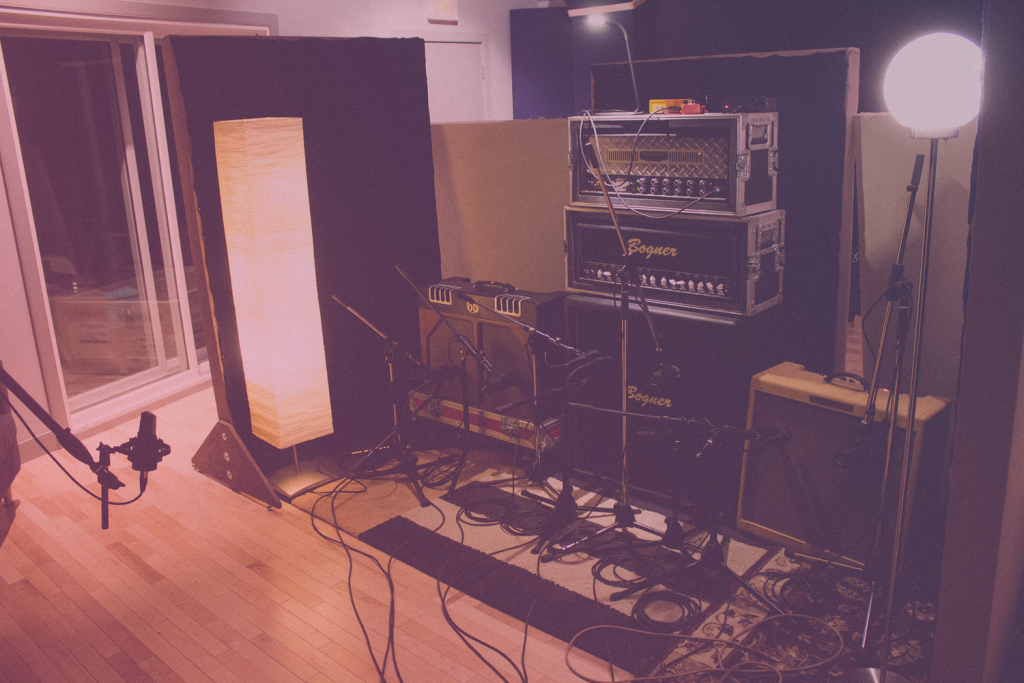
And while the sheer dearth of options is certainly a positive for the picky – it can also slow sessions, decisions and creative inspiration to a crawl. In the golden days of yore, you had one amp, one speaker cabinet and a couple pedals. Put another way, you turned on, you plugged in, you rocked out.
SIMPLE-MINDED, BUT FAR FROM STUPID.
Simplicity seems to be at the core of STLTones’ philosophy with their Tonality plug-in (PC / Mac. VST/AAX/AU $129.99 USD). Rather than bombard you with an impenetrable jungle of ten gazillion options, Tonality keeps it refreshingly, well… simple. With a focus on making the creation of your guitar tone intuitive and yes, of course, fantastic sounding – you get from point A to point B quickly and without an OCD-beleaguered amount of options getting in the way. Meticulously modeled from the session notes and amp collections of esteemed producers and engineers Howard Benson (My Chemical Romance, Kelly Clarkson, 3 Doors Down and countless others) and Mike Plotnikoff (All That Remains, Otep, Buckcherry), your basic palette of tones comes from six classic heads and cabinets and three pedals.
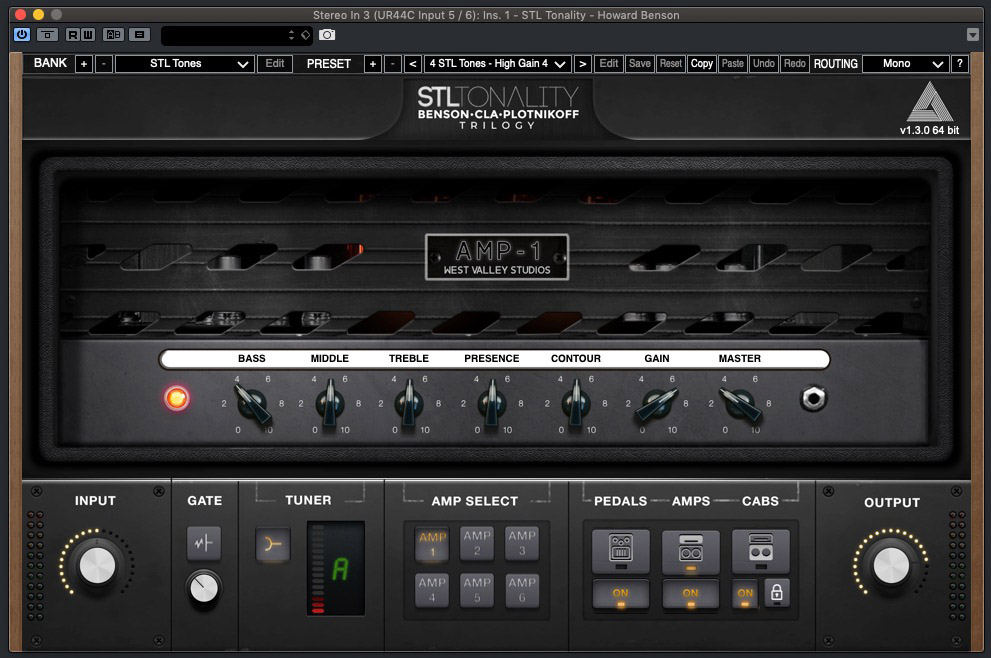
The amplifier head selection covers everything from vintage torn-tolex Brits to modern treadplate-faced gain monsters, with the inclusion of two bass amplifier heads (that can work just as well for that Josh Homme brand of desert rock fuzz). Each head offers the standard controls from the amplifiers that “inspired” them and are very, very faithful to the originals.
The cabinet selection is quite similar – featuring an array of big and small, new and old, tweed and tolex – while also allowing the user to load their own IR (Impulse Response) models for an even wider selection. Lastly, the three pedals offer an unbranded-ode to the TS9 Tube Screamer, widely used not as a main distortion but a nice big swig of additional gain – as well as a fairly basic reverb and a delay.
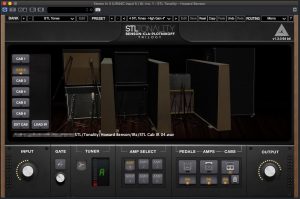
Navigating the interface requires nothing more than just a basic knowledge of the guitar recording chain, though some users might need to sneak an occasional peek at the well-written documentation. The amplifiers, cabinets and pedals all occupy their own tab and the UX is laid out to let you quickly switch through your choices. Rounding it out is an excellently simple tuner, input and output trims and a quite-intelligent acting noise gate.
If you’ve never actually grabbed the bakelite knobs on some of these classic amplifiers, Tonality isn’t here to judge. The plug-in comes with a very impressive selection of presets from Howard and Mike – many based on their actual setups from countless artists and sessions over the years. You can just start firing through presets until reaching that “voila!” moment – or start tweaking until you find something that works for your needs and start creating your own folder of greats.
ERTÖNIN ÜBER ALLES.
Whether your virtual rig keeps it more simple like this (guitar in, tone out) or goes all the way down the rabbit hole with twelve choices for the mic cables’ gauge and material, what matters is more than any bell or whistle is what comes out the other side. There have been many a plug-in where the interface might trick your ears into psychosomatically thinking you’re hearing a real Mesa Boogie or HiWatt – but there’s just something inherently ‘off’ about it. Around here we call that “the microwave burrito effect”.
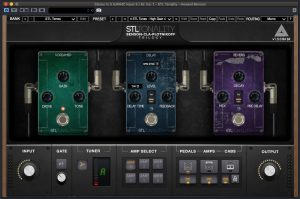
Yes, the thing on your plate might look like a burrito, might smell like a burrito and might be made from the same ingredients – but what you’re actually getting is just… “off”. Layer that falsehood up a few times in the mix and the guitars quickly become two-dimensional with no depth or excitement.
It’s that “realism” that sets Tonality apart. Crank the monitors up (responsibly), plug in, turn up and you actually get the sense that there’s a real half stack at the other end of your guitar cable. Chunked low power chords give the sense of actual woofer excursion and cabinet resonance. Leads and tenor parts have an extremely life-like voicing. Even the way the signal noise and interference picks up from your pickups and cable feels real.
In your more “traditional” rock and roll-geared tones, Tonality does not disappoint. You can very quickly find yourself with a ready-to-mix amp sound that would convince even the most die-hard of the analog purists that they’re hearing “the real thing”. Same goes for bass guitar – where Tonality gives adds heaps of rumble to your jungle. Lows are well-represented and round while the mids and highs can cut through the mix with a perfect bit of yip and growl.
Pushed into the darker arts of modern metal, Tonality really shows its teeth. Gainiacs will no doubt find enough unabashed DJENT to scare even the most progressive of suburban high school principals. The amps and cabinets faithfully take on even the most detuned, long-scaled, near-subsonic girth of today’s metal guitars and players, even as they tune to what we used to just call “the bass”. It’s that “djug” of a palm muted, drop F power chord that separates the men from the boys in these sorts of situations, and Tonality faithfully recreates these tones for the faithless.
ALGE BLOOMS.
We’ve saved the real important news for last here. STLTones is now working in partnership with industry stalwart and loveably outspoken curmudgeon, Chris Lord-Alge. You know Chris. Everyone knows Chris. Just listing the guy’s production credits would crash our humble server here so we’ll just say that, between tweaking the controls for U2, Green Day, Rolling Stones, Bruce Springsteen and about 23,905 others… CLA’s graduated from “engineer” to “enigma”
Priced as an additional $39.99 USD as an add-on to the existing Tonality suite, the CLA Pack gives the software an added feature and a whole different potential workflow. To be clear, the CLA Pack does not add additional components, amps or models to the suite – rather it provides modeling and presets from Chris’ ‘go-to’ processing hardware and methods – making your guitar tracks already scooped, polished, smashed and crafted to sit perfectly in any mix.
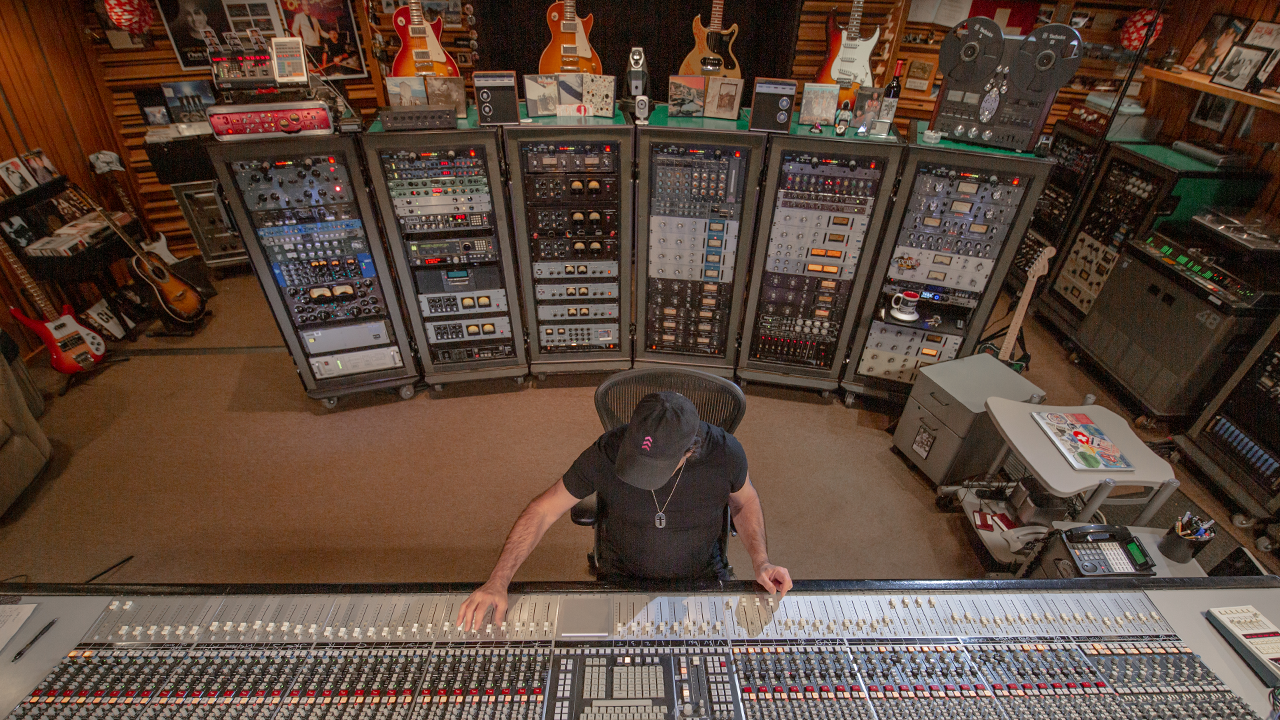
For the lesser-initiated, that “sound” is the alchemy of someone who knows which rules to break and how to break them properly. You could call it “simplistic extremity”. Chris is not afraid of the overload lights on his trusty SSL 4000 console and I’m sure his tech replaces just as many red bulbs as he does green. Input levels are pushed to the breaking point and beyond, where the once polite-and-proper British console sound has now had a few pints and wants to throw hands.
Similarly, the channel dynamics of these consoles are driven into extremes with both expansion and compression. His SSL console’s 242 EQ is often pushed up in the nosebleed frequencies (8-10k) to create an aggressive shear. Combined with his famed arsenal of vintage outboard compressors, the sound is glossy but not cheesy. Shiny… but not shrill. In your face… but it doesn’t spit when it talks.
The difference between working with and without the CLA Pack as part of Tonality really comes down to workflow. If you’re re-amping DI’d guitar or bass, Tonality gives you just the right suite of features and presets that you can then continue to work with in the mix just like you would a “traditionally recorded” guitar track. If you’re looking to get there and get there quickly, the CLA Pack will take those extra several steps and put Chris’ golden ears to work with a simple point and click.
THE HIGH NOTES. THE LOW NOTES.
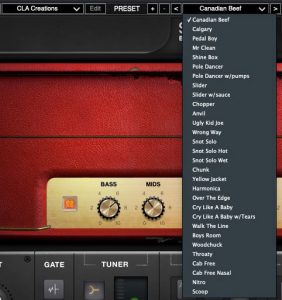
Everyone is looking for a guitar rig plug-in that speaks to the level of finesse and control they want over their tone. There are those of us who desire, if not need, to swap and tweak not just amps and cabinets, but to get granular with the microphones, placements, environments and everything else in the chain. And for those, Tonality might come up just a bit short on options. If that’s a deal-breaker for you, STLTones ToneHub is a tone tweaker’s theme park with hundreds of virtual amps and artist/engineer presets (they also sell many of these for your Kemper AxeFX if that’s your cup of chai). That’s not to say Tonality can’t or won’t get a killer tone out of the box, but that you might want to skip the cabinets section and use something like Two Notes’ Wall Of Sound to control those details.
But there are also those who don’t work with guitars as much – or might not be as comfortable creating an amplifier tone from scratch – or might simply want something that’s truly plug-and-play. Having a one-step process where you can simply plug in, set a couple of levels and have a truly realistic and multi-dimensional virtual amp is indispensable for everyone on that list. Add the CLA Pack and you’ve got a breadth of tones that are designed to be final mix ready – crafted by the man who’s been winning Grammys doing it for decades.
Whether you’re looking for a quick tone to get tracking or sleep more soundly with lots of options in your arsenal, every producer can find something to love about Tonality. Again, it’s not about having access to thousands of amp and cabinet combinations – it’s about putting the right amp and cabinet in front of you so you can get to making music. It’s core strength is letting sessions move at the speed of creativity. So many classic guitar riffs were spontaneous moments, and those moments don’t like to wait around for the engineer to futz around with mics, preamps and settings.
Criticisms? For me, the lack of a mic choice / distance / placement on the cabinets is a bit of a turn-off. I know that the plug-in’s designed to keep you recording and not tweaking, but that’s an important feature that can take “eehhh…. not feeling it” to “yes, that one, that’s perfect” – often just as much as the amp or cabinet itself. Additionally, a few more options on the pedals would make this part of Tonality feel less like an afterthought. In all fairness, you are welcome to use your pedals on the way in or as part of an analog re-amp chain later – but that does defeat the purpose of keeping this plug-in as your one-stop-shop. I’d love to see pedal makers like JHS or Earthquaker hop into the STLTones world. If I could add a Wampler Nirvana or MXR Phase 90 pedal as an option for a few bucks more, I would gleefully pay for the upgrade.
SIX STRINGS IN ONES AND ZEROES.
I feel obligated to mention that, for tracking guitars directly – not all interfaces are created equal. Many all-in-one type front ends do provide an instrument level (hi-z / high impedance) 1/4″ input that is most certainly serviceable, sometimes even excellent. Others don’t. Remember, Tonality (or any plug-in) is only as good as the signal you feed it.
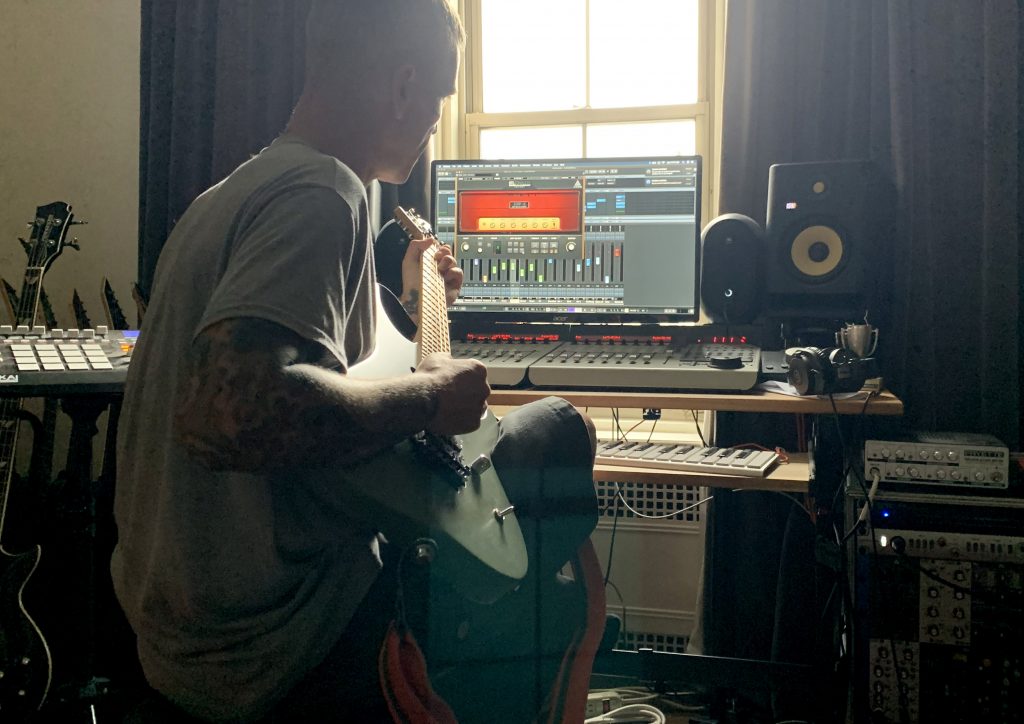
In chasing those last little crumbs of making the tone perfect, consider your cable and DI options. The difference between a $10 and $30 guitar cable can be quite audible, especially as this unbalanced TS connection is stretched beyond fifteen feet in a world besieged by RF interference. A dedicated DI box (I’m a Countryman-guy myself) to convert your guitar signal can add some depth and a more even-keeled frequency response, as can using a dedicated hardware preamp or channel strip to shape your incoming signal (I use the instrument input of the SSL Alpha Channel for this for just a touch of it’s VHD preamp and excellent EQ).
Does this mean you can’t record without this kind of hardware? Of course not. It is simply my experience that a little extra attention to the way the instrument itself is brought into the digital world can help you take the most advantage of the options that something like Tonality gives you.
TONALITY = FINALITY?
I really like and appreciate the niche that STLTones Tonality fills and know many others who do, too. It’s the quintessential Baby Bear’s porridge: It offers more than enough models, tones and presets to get the tone you’re looking for, but does it with minimal fuss so you can focus on the playing and recording. It’s priced attractively and most importantly, the sound is as authentic as you’re going to get out without hauling a hundred pounds of equipment into the room (and assuming you have the space and equipment to properly record it).
Tonality is as intuitive and easy to work with as you’ll find anywhere and is coded lean enough that you can track with it at low buffer settings. The CLA Pack is just the thing if you don’t have the time, patience or experience to make your guitar tracks shimmer in the mix – or you want to use it as a great jumping off point to tweak some new presets of your own.
Tonality’s been part of my own guitar plug-ins folder since it was first released in 2018. It’s got some serious competition in my studio, which has not only a few other plug-ins, but a Fryette Valvulator tube preamp and the classic “redface” POD XT Pro that started this whole revolution to begin with. It’s as strong a contender for your desert island virtual guitar rig as anything else out there. At the end of day what matters more than anything else is how it sounds – and STLTones delivers a big mouthful of meatball-sized tone.
Right now STLTones is offering the CLA Pack for FREE with the purchase of Tonality. Use code: STLCLA at checkout.
(Offer good until August 28, 2020)
For more information on Howard Benson Tonality, visit https://www.stltones.com/products/stltonalityhowardbenson
For more information on the CLA Pack, visit https://www.stltones.com/products/chris-lord-alge-trilogy-preset-pack



